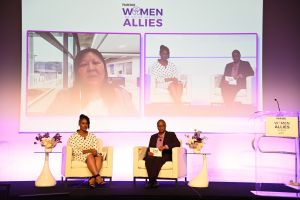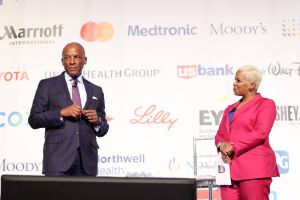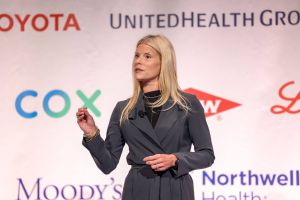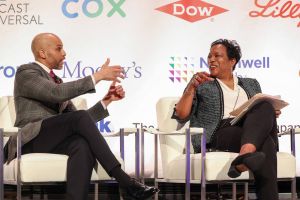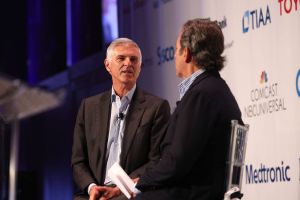During a Fair360, formerly DiversityInc 2021 virtual Fireside Chat, David Cordani, President of Cigna Healthcare (No. 33 on The Fair360, formerly DiversityInc Top 50 Companies for Diversity list in 2021), spoke with Carolynn Johnson, CEO of Fair360, formerly DiversityInc., about leading a Fortune 500 company during the past troubling and challenging year, the value and importance of data transparency in business today, and what he sees as corporate America’s responsibility in helping to bring about impactful, irreversible, sustainable change. Here’s a look back at their conversation.
Johnson: We are very pleased to welcome to our virtual stage Cigna’s David Cordani, who’s served as President of Cigna Healthcare since 2005, and as President and Chief Operating Officer of Cigna Corporation since 2008. David, thank you so much for joining us here today. We are thrilled.
Cordani: It’s good to be with you today. Thanks for having me.
Johnson: OK. Awesome. So let’s dig right in. Diversity and inclusion are major areas of focus for many organizations. I know that you will be serving as the chair of Cigna’s Diversity Council. What does diversity and inclusion mean to you right now, and how have those experiences, and also the events, the media, et cetera, impacted your viewpoint over the years?
Cordani: First, let me add my congratulations to your team and appreciation for the great work your team does. I did smile when you said they were kicking COVID’s butt, I truly appreciate you and your team’s leadership. As I step back and think about the DE&I for our organization, in total, from a simplified societal standpoint, we’re a global health service company, which means we actually have the good fortune of serving 175 million customer relationships around the world.
So, as we close our eyes and think about it, we touch and serve people of all walks of life, literally across the globe. So, diversity, in the broadest sense of the word, needs to guide us to go forward and fulfill our mission, which is to improve the health, well-being and peace of mind of everyone we serve. The recent environment just amplifies that even further — not in a positive way, through some lenses, but we need to turn that into a positive way. The senseless murder of George Floyd, I think, caused everybody across the globe — which was the power of it, the unfortunate power of it — to stop and ask very different questions around why, and what we can and need to do differently. And as you noted, within Cigna, while we’re proud of many of the things we’ve done, our council helped to supercharge our activities even further.
Johnson: And so, now I’m thinking about inclusion. I know the efforts within Cigna are ongoing, as they will be in many organizations. How have you and your leaders continued to leverage data transparency to help shape Cigna’s inclusive workplace that supports authenticity and helps employees feel like they belong?
Cordani: So — and I really appreciate the “feel like they belong” so, I’ll come back to that on the back end — but data’s a tool, and it’s a tool that we have an opportunity to use responsibly. But we need to be prepared to deal with the consequences of using it. Because data use effectively guides insight, and insight informs action and helps to guide it with more precision.
So, a couple of examples. One, for quite some time, we’ve been able to use data effectively to assess pay equity within our company. So, I’ll come from within first and look at pay equity within the corporation to challenge ourselves, to ensure that we had appropriate efficacy in our pay equity. And for example, this past year, in 2020, our pay equity between males and females is 99.9 to one. So, it’s almost perfect. One-to-one is perfect. And you strive for perfection every day, but it’s close to a Six Sigma measure. And for people of color and not people of color, it’s 99.7 to one. Again, close to perfect. So, that’s an example of using data from within the organization.
Another example of using data is, using it as a guide to help us expand the way in which we work with minority-owned, women-owned, people of color-owned suppliers. So we’ve made a pledge to double, to a billion dollars, our minority-owned supplier service utilization. But we don’t just don’t set a goal, we use the data to guide it, and the data helps us identify, in some cases, smaller suppliers. And then we sought to partner those smaller suppliers with Cigna leaders over an 18-month period of time, almost like a partner in a championship program. So, that helps us.
And then, ultimately, we pause. We step back and we ask our colleagues, our 70,000 colleagues around the world as part of our engagement surveys, do they see us creating an environment that embraces diversity, that embraces different perspectives, that supports different perspectives being brought to the table, that allows people to express their individualism? And we tend to rank quite highly there. But we’re not sedentary. So, data is a powerful tool when you use it responsibly, as a guide to action and as a relentless continuous improvement set of actions for your organization.
Johnson: OK. So it’s been close to a year, David, since I was honored to partner with you and other Cigna team members for a virtual panel on racism. If you recall, we had the pleasure of also having Magic Johnson and Dr. Valerie Montgomery Rice on that panel. This discussion continues today in communities, organizations and companies we talked about earlier, during one of our Fireside Chats with Roy Wood Jr., about a young lady in Jersey City whose teacher made her talk about why Black lives matter. He wanted her to talk about that and validated that point to her. And so, these conversations around racism and what is happening in the classroom and in the workplaces are ongoing. So, what do you see as the role of large companies in this conversation?
Cordani: I think it’s a very challenging question, first and foremost. I actually think it’s a simple question at some level, but it’s very challenging. And as I step back to answer your question: One, we believe, and I personally believe, that corporations have a role and have a set of responsibilities. So, I embrace that. Two, we believe that it should be informed and heavily guided by the mission and purpose of the corporation, and that should guide your focus. And three, we believe that the mission of the corporation needs to be the primary guide, not the bias of an individual or the perspective of an individual alone. Because when you’re a part of a corporation, just like when you’re part of a team, you buy into something larger than yourself. You choose to be part of something that is larger than yourself. And I articulated our mission, which is to improve the health, well-being and peace of mind of those we serve.
So, we put ourselves in a position of service. And so, converting that to an example of an action and then driving change during the COVID environment: Multiple years ago, one of our teams in Atlanta, for example, sought to take action. And they essentially, in my words, “adopted” a school. They worked to provide support to a school, Humphries Elementary School. Now, Humphries is in a very challenged part of Atlanta. The income level is low. The population of that grammar school — I call it a grammar school. I’m a little old school — that grade school is essentially about 90% Black and 10% Latino. And it was challenged. Our team stepped into that challenge with the administration and worked to provide food — on the weekends as well, for the kids — additional resources, clothing, laptops, worked to create a fun room, a gaming room, et cetera, that were reward-based, based upon attendance.
And guess what happened? Attendance went up, behavioral issues went down, academic performance went up. Well, then COVID transpired, as you articulated in your opening. Well, a lot of things changed. But these kids, these children still needed support. And our team worked locally again, to figure out how to help to provide that very important first step, which is food. Food safety and food peace of mind are mission-critical to a child’s health, well-being and peace of mind.
That’s an example, to me, of something that is highly on-mission to the role of a corporation. And it’s an example of a locally converted and locally owned body of activities. And what we try to do is, we try to have a multiplier effect on that because ultimately, most change and most impact takes place on a very localized basis. And I view that as an example of a phenomenal success. Our corporation, guided by its mission, owned by our coworkers, converted locally and then perpetually innovated over years to have an impact.
Johnson: So, the opportunity to get to know Susan Stiff, Melissa, other folks on your team has been a rewarding one. And it’s given me an opportunity to really think about influence. And so, last year, when we partnered on the conversation around racism, what I thought was interesting is, companies were bringing people in to talk about it, but leaders were not part of the conversation and you were. You were right there, front and center, and you gave your opinions, your viewpoints, but you committed to being part of the solution.
So, while I have a viewpoint of how you are exerting your influence, can you share, David, some other ways in which you are using your influence as a solution to end racism, food and shelter and acute insecurities, and some of the other things that you just talked about in your last answer?
Cordani: Yes. So I’m trying to convert it with, again, some concrete examples, and I appreciate your kind statement very much. So, as we step back, you articulated the importance of data and insights. In our business, all healthcare is deeply personal and highly localized. So, as an example, what we did is, we stepped back in the last year and we said, we could see that, in the United States, small business, businesses with 50 or fewer employees, tend to be underserved from a healthcare standpoint in general. And minority-owned small businesses tend to be further underserved because the programs that are typically offered for those buyers are highly standardized. The people are not standardized, the people are quite unique.
So, example one, we partnered up with Magic Johnson Enterprises and we had a vision. We said, “Let’s build from the ground up a small employer solution. Let’s launch it in LA. Let’s make sure the clinical programs are designed to meet the unique needs of certain subpopulations. And let’s bring it forward with a kind of perpetuation for the benefit of that market.” Something net new didn’t exist in the marketplace…
The second example is, we know that in Chicago, especially the south side of Chicago, down to the Bronzeville section, the violence epidemic continues to grow. Now, we can look at that and we can actually look at that zip code and those zip codes instructing us that average life expectancy is lower, there are certain health issues, but we could correlate some of that back to violence. So, through our foundation, we provided a grant and we went to work with faith leaders and community leaders in what some would view as a very unorthodox way. We don’t view it as unorthodox. It’s highly localized, with influencers where we can align on goals and objectives and seek to make an impact and drive change. That’s the second example.
And then, lastly, globally right now, we’re challenging ourselves leaving the United States. We all see the headlines relative to the massive challenge in India right now. We could observe that from afar or we can step in as a global steward and a global health service company. So, we’ve partnered up with UNICEF to provide more resources. We’re matching donations from our colleagues through our Cigna Foundation to provide more resources.
So, each of those examples is localized, guided by our mission, but calling us to act, not observe, calling on us to take action and to take perpetual actions. And in most cases, with partners — so, identifying, how do we come up with a partner, so we can extend our leverage or extend our impact or supercharge our pace from that standpoint?
Johnson: I think that’s a great segue into the next question because you underlined acting. So how can a company really work, not just talk about it or use it as a marketing or PR tool, but how can a company really work to promote change and lead that change for making a difference — not just for their workforce, but in the communities they serve?
Cordani: So, I think first, I don’t believe there’s an easy answer to that. I think each company has its own answer, right? Each company is its own being. We talk about, in our organization, virtual communities. A company is a virtual community. It brings forward a group of individuals with a common purpose from that standpoint. So, to me, it comes back to, it’s a little bit of a gut-check moment. I apologize for my crude terminology, but it’s a gut check: Do you want words, or words and actions? And to your initial question, are you willing to use data measurement and even incentives and rewards as a guide to action? And I’m not saying that we have all the answers, but for example, we set specific actions, goals and objectives. We try to measure our performance. We seek to engage and listen with partners and drive ourselves forward.
So for example, this year, a portion of the management incentive compensation program attaches back to our DE&I goals and objectives. And those are both externally facing and internally facing goals and objectives, impacts on health disparities, as well as representation inclusion — the supply-chain indications I made reference to before. So, tying that together, is there a commitment? Is there a willingness to match words and actions? Is our willingness to inform it with data? Are you willing to reinforce it with incentives and disincentives?
And then, if you’re really serious about it, are you willing to identify partners that could create even further leverage to your programs? And then, when you start to see it moving, actually, you get that groundswell within your organization, seeking to do more. We have demand within our organization of volunteerism or idea generation to do more or bring additional activities to the table.
Johnson: So when we talk about action and steps forward, I know over the past year you all have taken some huge steps forward in ensuring a more inclusive environment. Of all the work that you all have done, is there one action you can leave us with that you see as truly meaningful?
Cordani: Your question is from within the organization, as it relates to inclusion and representation?
Johnson: Yes, that’s correct.
Cordani: I think I start from the top, then, as it relates to that. As it relates to measures and actions, something I’m extremely proud of. And again, we’ll never declare a finale or check a box relative to success. But if you look at the makeup of our board of directors, we’ve organically constructed a highly diverse board of directors to guide our organization.
And if you look at the leadership team of our global corporation, the leadership team is a diverse leadership team. I don’t declare perfection on either, but they are representative of what we seek to be. And it is a perpetual evergreen body of work, as opposed to putting that aside and saying, “We’re going to work on these other things.” It needs to transcend all aspects of the corporation. So, you use that, if you will, the shadow of the leader from the top, whether it’s governance through the board of directors or our enterprise leadership team, and then we carry it through the many actions we just talked about. I think those are reinforcing mechanisms from outside in and inside out that our company is quite proud of.
Johnson: Yep. So, David, we’ve talked a lot about sickness strategy and goals moving forward. But I want to shift a little bit and talk about you for a moment, and your personal experiences. So, how have your personal experiences impacted your view on the importance of corporate diversity and inclusion?
Cordani: So, maybe I’ll ask this question in a little unorthodox fashion and kind of steer off the rails a little bit. To me, we’re all products of our upbringing. So, I’m born and raised in a blue-collar family in a small town, raised in my grandparents’ house because my parents were married quite young, and I saw a different part of the world through that very small lens in a small city in Connecticut. And from that perspective, I learned relatively early on, hammered home in my brothers and I by our grandparents, in terms of a bit of civic responsibility and a bit of the golden rule. They were just hammered home into us. The golden rule, treat people the way in which you want to be treated. And if I fast-forward to the present environment, a basic recipe I’ve converted it to in the present environment is a framework that we talk about in the corporation.
Stop, listen, seek to understand. When we project, when we think we know, when we read the age-old book by its cover, we make mistakes. So, when in doubt, slow down, stop, listen and understand. Because whether you want to make a difference, or drive an action or have influence with an impact, you need to first and foremost understand any environment or any person before you can have influence or seek to help.
And I find that in this current environment we operate in, we tend to jump past all those steps and either drive to action or assume other parties have either a point of view or a perspective of behavior otherwise. So, for me personally, I’m a very action-oriented person. My team will tell you that I’m sometimes impatient. I try to tell myself, “Slow down, stop, listen, ask the open-ended questions.” I like to learn. So seek to understand, and then you can drive more effective actions together, by locking arms and creating a leverage effect. And, to me, that’s a much healthier perspective.
Johnson: So, Cigna has a goal of reaching gender parity, specifically in your leadership pipeline, by increasing the number of women at your director and senior director levels from 45% to 50% by 2024. How are your data transparency practices driving the achievement of this goal?
Cordani: Yes. So, that’s a powerful bridge between the two. So, when we step back and look at the goal and the objective, ultimately, we take a look at the pipeline. We’re able to take a look at our pipeline of colleagues from within the organization. We’re able to look at our performance, our career development process, our development programs, et cetera, and proactively partner to enable the growth of and support of individuals to ascend through additional roles. And it’s a recipe we’ve applied elsewhere in the organization by identifying individuals, identifying target roles, goals and objectives, identifying very developed multidimensional improvement programs or career skill-building programs, and then mirroring up with sponsors or champions, et cetera, to be able to drive it forward. And then, my leadership team, the enterprise leadership team, meets at least twice a year for a day and a half to go through our talent priorities.
That’s all data-driven. Ultimately, it comes back to individuals, but it’s data-driven relative to, how well are we performing? And then looking at the health of our pipeline, looking at turnover measures, looking at causality relative to turnover, looking at success profiles for individuals who are ascending through various levels in the organization. And that type of discipline recipe has served us quite well.
But on the front end, we started with the point I made before: We set the goal. We set the goal, we hold our leaders accountable relative to it, then we apply with the data, the recipe, and then we go through our execution framework relative to it. And I am quite confident we will achieve that, because we will remain committed and disciplined relative to applying that framework, using the data and the measurements and reinforcing it with incentives within the organization.
Johnson: So, this is on our list. The last question, although I do have one follow-up after this. And that is when we talk about influence — so, there were, I think, 13,000 people on the last web meeting that we did together, and not all of those people were employees of Cigna. So, knowing that you have that type of influence to draw people, knowing that they’re interested in your model behavior, how do you hope to see diversity and inclusion change at Cigna over the next year or five years?
Cordani: It’s a great question. It’s what I lay up at night thinking about, anyways. Because in some ways, the easy answer is, it is so fundamentally ingrained in routine as it relates to the way in which all 70,000 colleagues act, react, interact, prioritize each and every day. It’s not a separate focus item. It’s just a fundamental part of the fiber. So, when I boil it all down, that’s where success is. When I look at a recipe that a great athlete applies, they have a formula that becomes second nature. When you look at great artists, they have a formula that becomes second nature, and they’re committed to the discipline of it. And the important part is, they love the journey. So, it’s not the destination, it’s the journey. It’s acceptance of all, that it’s not only the right thing to do, but it’s also a good thing to do.
And there’s a measurement of success that is positive and rewarding, and the journey — of, in this case, diversity, equity and inclusion — becomes the reward. It becomes a reward as opposed to a destination of achieving a target of a billion-dollar supplier number, or the 50%, or, or, or. Those are steps along the way, the pause. But the destination is less the objective, it’s the journey that perpetuates all, in our case, 70,000 folks, that organically comes to life each and every day.
That’s the evolution that I see as the next step within our company. And I think it is the next step from a societal standpoint because when that transpires, you’re there, it’s sustainable. It’s a part of the fiber. When it’s stimulated either artificially or a project or a program, it’s still in a fragile state. Anything that’s stimulated as a project or a program or with a task force, it’s important, but it’s not yet sustainable. It’s creating that sustainability that transcends every aspect of every fiber of every action that transpires that puts us there. And that’s within our reach. That’s the exciting part of it. That’s totally within our reach.
Johnson: And my last question is, it’s really one where I feel like folks would benefit from hearing, even if it’s just three things. But as it became clear that there was a differential experience for some in the workplace or the community or even in the classroom, that experience was more differential for some than it was for others. What, David, were three things that you did to better inform yourself about how to be part of the solution? Because it was a lot, if I’m honest, to watch the video of George Floyd having his neck kneeled on. That was a lot, and I know it was a lot for others. And some people were paralyzed and others sprang to action. So, what three things, to leaders, would you suggest they do to become better informed?
Cordani: Well, I’m not sure. You smiled. It was funny when you said you had an extra credit or follow-up item. So, I wondered, because I saw your smile and your energy coming back at it. And to that end, I’m not sure I have the silver bullet by any stretch of imagination.
But, to me, when you confront something that is really complex or multilayered — or, in the case of what we’re talking about, not only complex and multilayered but highly emotional and potentially highly polarizing — to me, the only way you can advance the conversation, the actions, the acceptance of it, there’s got to be a level of vulnerability that’s created. Because when there’s a level of vulnerability, that has to come through in an authentic way. So, when there’s a level of vulnerability and authenticity that comes through, then layers could start to come down. Then the guard could start to come down. And only then do you have the ability to listen and understand.
Otherwise, you run the risk of cutting along the edges, or swimming across the top or having an engagement or communication that you think you got to the perspective but you didn’t. You didn’t get to the perspective. And we had, for example, in our company, I’ll try to boil it down in a second here, we had some highly engaged, I’ll call them “listening sessions,” that were the most — outside of corporate America or anything beyond — they were the most raw, emotional things I’ve ever been through in my life. Exhausting, just fundamentally exhausting, but the rawness of it and the clarity of it and the humanity of it was invaluable. So, on one hand, you’re like, “Oh. my gosh.” But without the vulnerability and the authenticity and creating a safe environment, then you can’t move forward. So, to me, that’s everything.
And then, being careful not to over-promise. And that doesn’t mean don’t set high goals. My colleagues will tell you we set high goals. But be careful not to over-promise, because what you say you’re going to do, you’d better do. And when you don’t, or if you make a mistake, you’d better own it in a millisecond, because we’re all human. I’ll make mistakes. Our company will make mistakes. You need to own it with transparency. But as long as your colleagues and your stakeholders see that you’re authentic, your purpose is noble, and you’re going to [seek] continuous improvement, locking arms together, that’s where the good starts to come. And I think societally, we need more of that. We need more of that level of vulnerability, trust and willingness to lock arms to move forward. Without that, I think we’re only dealing on the fringes.
And, to me, the video you articulated was a stimulant within our company to have very different levels of engagement, and I know that I personally massively benefited from the levels of insights I received from many of those engagements. Hope that’s responsive.
Johnson: No, it was great, and great words to end on. And so, I really do appreciate your time today, your thoughtful responses. And most importantly, humoring me in that last question. I really do appreciate it.





